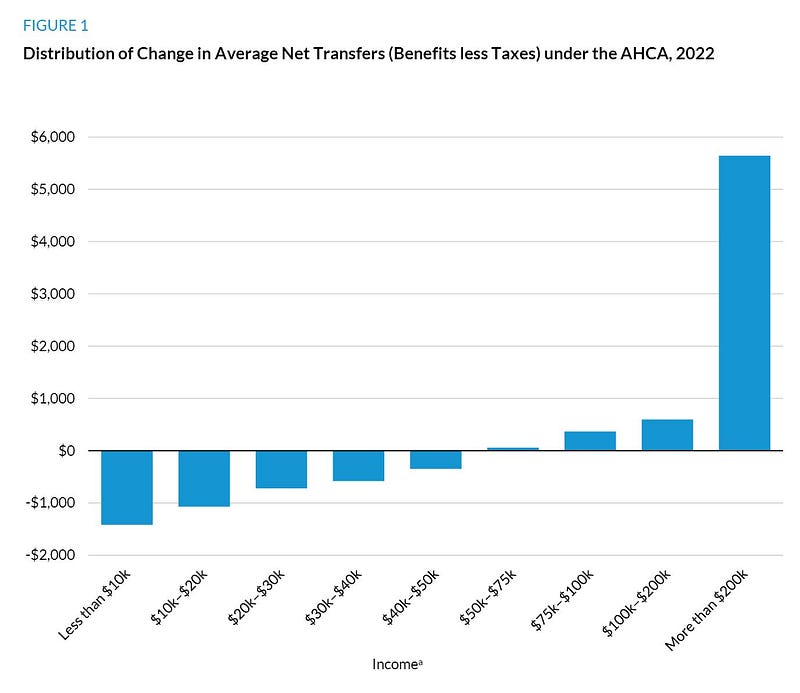We Finally Know What’s Going to be in the Senate Version of Trumpcare — and It’s Not Pretty
For weeks, Senate Republicans have negotiated their version of Trumpcare in near total secrecy. There have been no public hearings — just private meetings among a select group of Republicans about a bill that could reshape one-sixth of the American economy. For many Americans, the contours of the bill could be a matter of life and death.
Text of the bill was released on Thursday, but key details began to leak Wednesday night (some from lobbyists who learned about the bill before the American people). Majority Leader Mitch McConnell (R-KY) is insisting on a vote before the July 4th holiday, which means everyone has a week to learn about this bill — including many of the senators who will be voting on it.
So let’s get started. Here are the most important things you need to know.
The bill would strip health care coverage from millions of low income Americans by rolling back the expansion of Medicaid — and then making even deeper cuts.
The core of the Senate bill, like the House version, is a massive cut to Medicaid, which millions of low income Americans rely on for health care coverage. The Senate bill will reportedly phase out the expansion of Medicaid under Obamacare, although the process won’t start until 2021. In the end, the impact is the same. The Congressional Budget Office found that rolling back Medicaid expansion would cost 14 million people their health insurance.
But the Senate bill makes even deeper, more dramatic cuts to Medicaid that, over time, would leave more low income Americans without health coverage. Instead of a program that pays for health coverage for people who need it, the House and Senate versions of the Republican health care bill place per capita caps on the program. In other words, the federal government will only send states, who administer the program, a certain amount of money no matter what the actual cost of care may be.
The Senate version, according to a report in Bloomberg, makes even deeper cuts than the House.
The House bill ties these per capita caps to the “growth rate of medical inflation (CPI-M) plus 1 percentage point.” The Senate version, however, ties caps to the general rate of inflation (CPI-U). Since medical costs consistently grow at a much faster rate than overall costs, this means states would receive a smaller and smaller percentage of the actual cost of care each year.
The bill would follow the Obamacare subsidy model, but help fewer people.
In the House version of the Republican health care bill, people receive premium subsidies based on their age. The Senate bill retains the Obamacare model where subsidies increase as incomes go down.
But while Obamacare provided subsidies to anyone making up to 400 percent of the poverty line, the Senate bill ends subsidies at 350 percent of the poverty line. This means fewer people will get help. For some people, the impact of this change could be dramatic.
The Senate bill is a massive tax cut for the rich.
At it’s heart, Trumpcare is less a health care bill than a tax cut bill. There was speculation that the Senate bill would leave more taxes in place, but it will largely mirror the House version, according to the Washington Post.
The Senate bill will repeal hundreds of million of dollars in taxes that Obamacare used to help more people afford health care providing a massive transfer of wealth to people with incomes over $200,000.

CREDIT: Urban Institute
The bill will mean higher out-of-pocket medical costs for many people with insurance.
Republicans would like to reduce health care premiums. But the only mechanism to do so in the Senate bill is to allow insurers to provide fewer benefits. That means, for some people, premiums may be slightly lower. But those same people will end up with far greater costs if they do get sick.
The Senate bill will reportedly give “states more leeway in opting out of the ACA’s insurance regulations through expanding the use of so-called ‘1332’ waivers already embedded within the law.” (The House bill creates a new waiver program.) The waivers are not expected to allow states to let insurers reject or charge more to people with pre-existing conditions. But the waivers will let states allow insurers to offer skimpier plans, potentially leaving consumers with huge medical bills.
The bill also reportedly changes what percentage of costs, on average, an insurance plan must cover from 75 percent to 58 percent. This means more deductibles and out-of-pocket expenses. The Senate plan could increase these costs by 68 percent.
The bill will seek to limit the ability of insurers to provide coverage for abortions.
Senate rules may prevent the Republican health care bill from including explicit restrictions on coverage for abortion. The Senate is exploring an arcane way to limit abortion coverage anyway, according to Axios. The Senate may create a “stabilization fund” that insurance companies can tap into through the Children’s Health Insurance Program (CHIP). Most insurers will want to take advantage of this fund. But CHIP already has a restriction on abortion coverage. So insurers that take advantage of the stabilization fund will not be able to include coverage for abortion.
The bill will hit older Americans especially hard.
Across the board, older Americans who use the exchanges will be expected to pay a larger share of their income for health insurance. Those who make over 350 percent of the poverty line will now be expected pay full price.

Trumpcare’s passage is far from certain, with a number of moderate and conservative Republicans raising objections. Conservatives are likely to balk at keeping the basic Obamacare subsidy structure. Moderates are likely to object to the aggressive Medicaid cuts, particularly in states that have expanded Medicaid.


